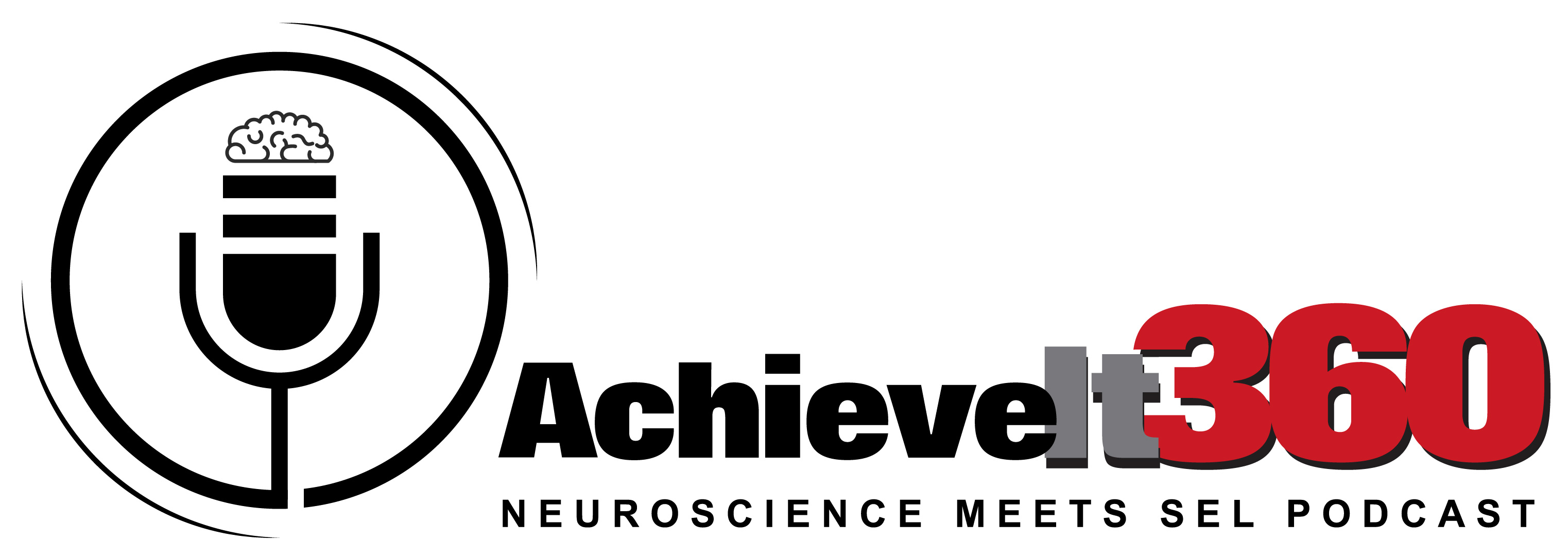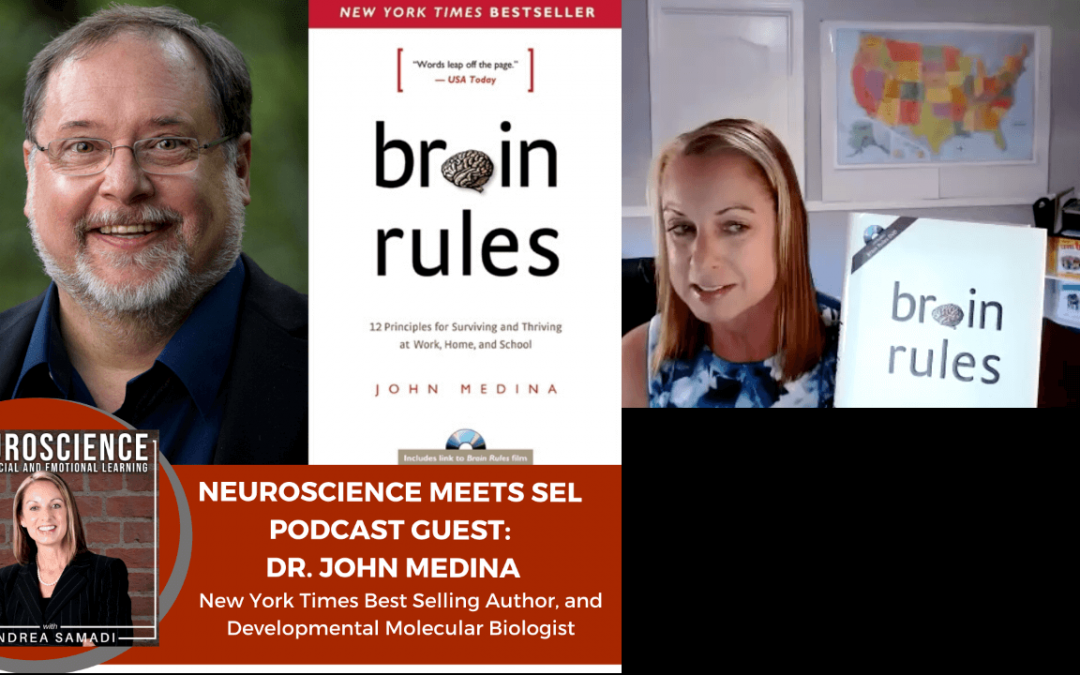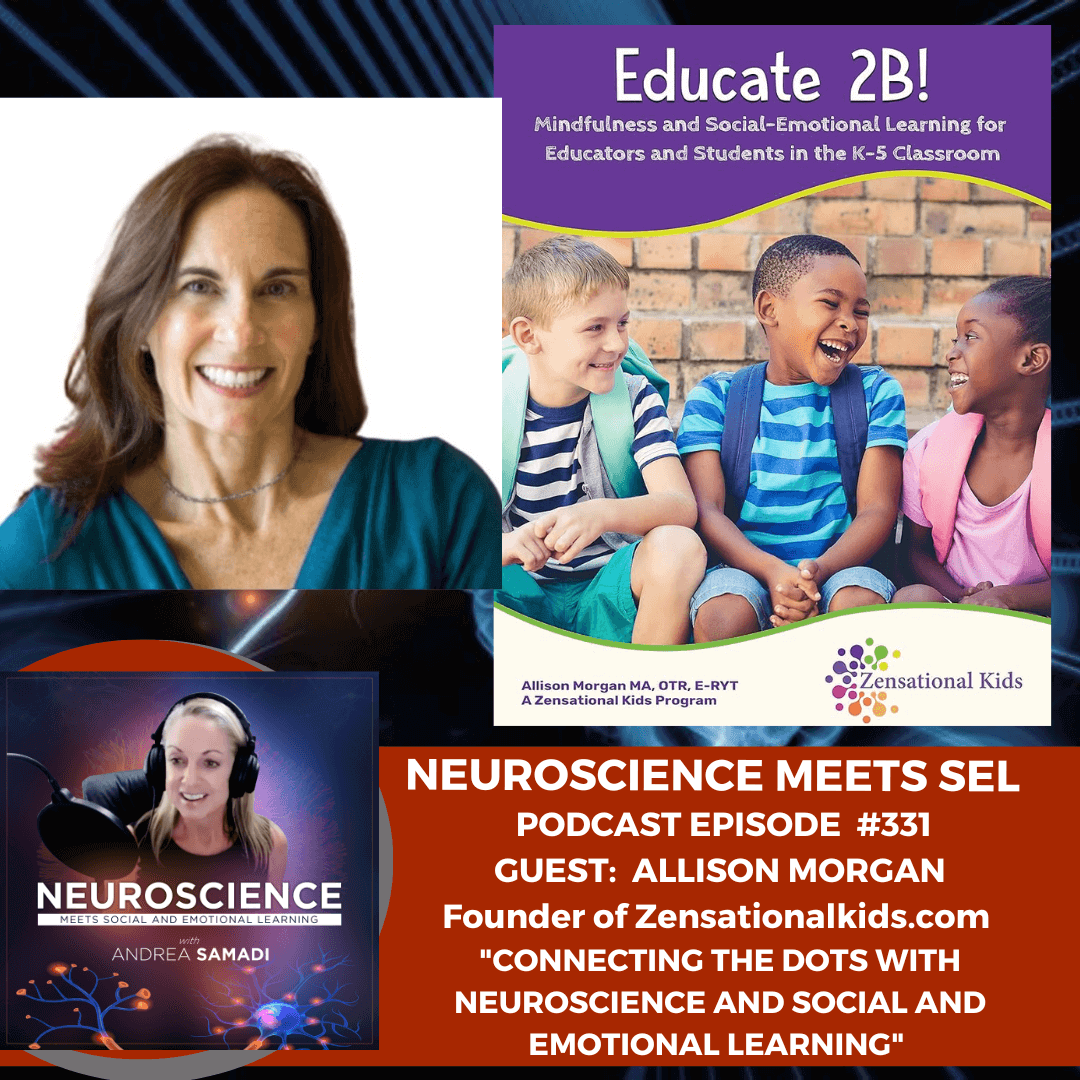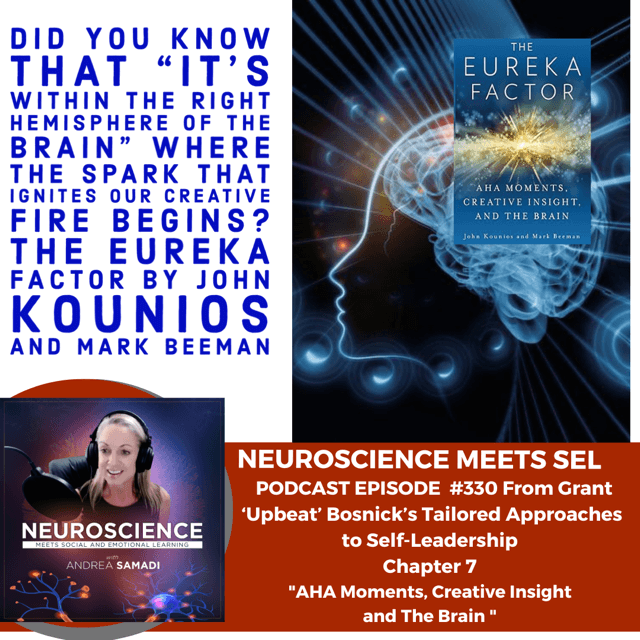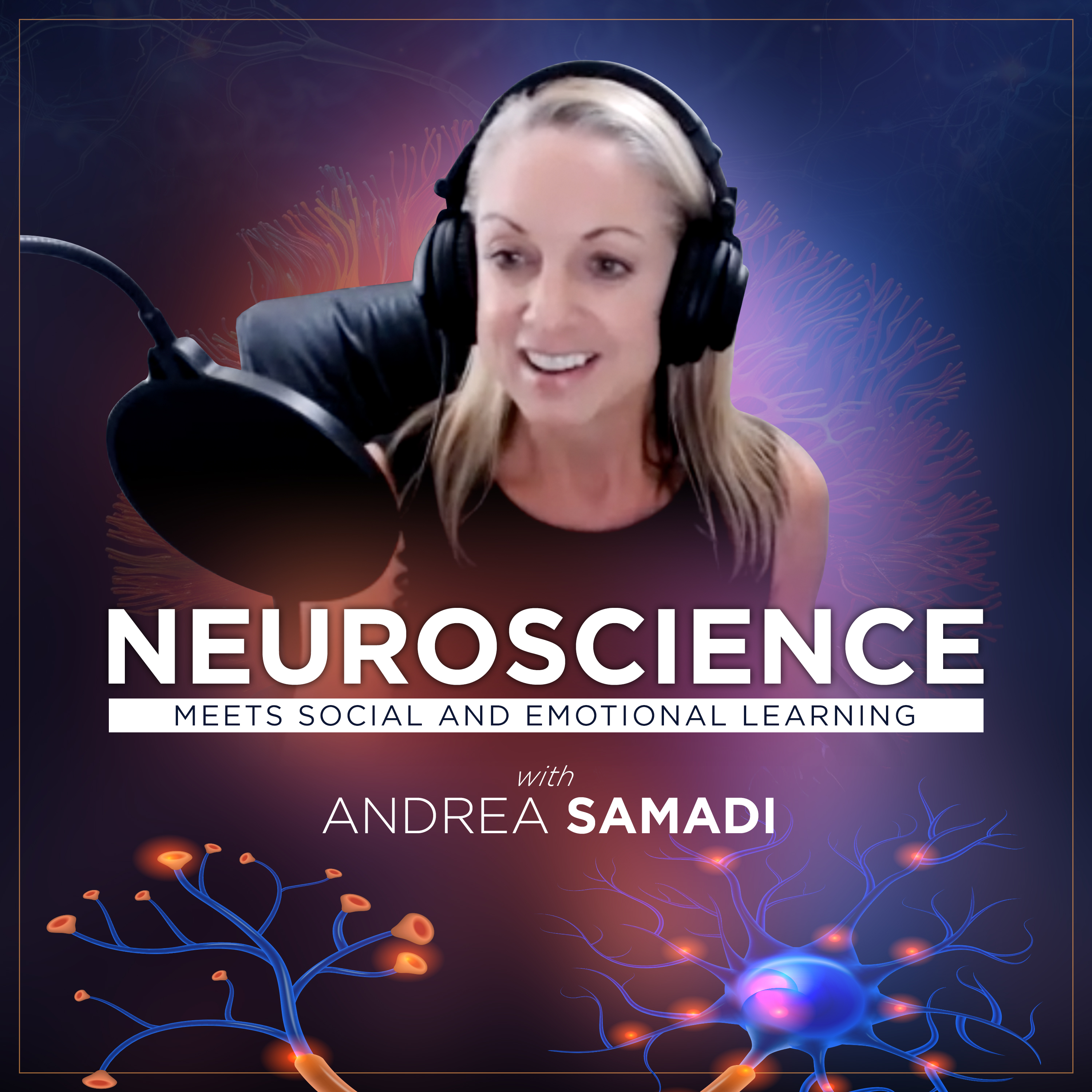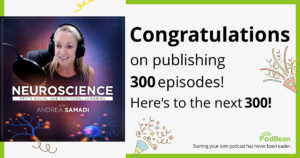This is episode #43. Welcome to the Neuroscience Meets Social and Emotional Learning podcast, my name is Andrea Samadi, I’m a former educator whose been fascinated with understanding the science behind high performance strategies in schools, sports and the workplace for the past 20 years. The next three episodes will be solo lessons to dive deeper into Dr. John Medina’s episode #42 that I could probably spend the next year on.
For those who have not read his Brain Rules book, or would like a quick review, I’ll outline them briefly with thoughts on why they are so important to implement into YOUR daily life with some applicable strategies. Here are Dr. John Medina’s Brain Rules[i]: If you click on the link in the show notes, you will be taken to his website and can watch a video on each rule. I also highly recommend reading the book, because there are so many examples that will bring these rules to life.
RULE 1: EXERCISE: Exercise boosts brain power.
Did you know that “aerobic exercise, just twice a week, halves your risk of general dementia? It also cuts your risk of Alzheimer’s by 60 percent.” (Summary Rule 1, Brain Rules, Page 28). I also heard this from Dr. Daniel Amen in his “Thrive by 25”[ii] online course where he talks about a recent study that rigorous aerobic exercise over a 12-week period, was just as effective for those suffering from depression as taking an anti-depressant. This class talked about the fact that aerobic exercise, like brisk walking, swimming, running or cycling seems to solve EVERY brain or health problem. The solutions were always to improve your diet and add aerobic exercise. This should be incentive enough for everyone to be sure they are moving at least 3 times a week for at least 20 minutes, or that’s what Dr. Medina would say will have an impact on your brain and improve cognition, problem solving and emotional regulation. I found it interesting that he mentions that strength training did not improve cognition in the studies, but I still think both strength training and aerobic exercise are important to do on a weekly basis, regardless of whether one is making you smarter or not. The latter will definitely make you stronger and is important to include as we age.
RULE 2: SURVIVAL: The human brain evolved, too.
I’m sure by now you have heard that the brain’s main function is to keep us safe, something that’s been built in for our survival. If we think about evolution and the survival of the fittest, what happened with the human brain when it evolved and adapted over time was that the brain got smarter with evolution, not stronger. We can clearly see how the human brain and cognition is vastly different than other animals. The human brain consists of 3 main parts (the hindbrain that developed first, that keeps us breathing, the midbrain that keeps us alert and where our emotions are stored and the last part of the brain to develop, the forebrain that holds the most power with our thinking/reasoning, emotional regulation, and cognitive functions. Our ability to think and reason is what separates us from the animal kingdom and a feature of our brain that we shouldn’t waste or take lightly. Since we have this unique ability, I think it’s our responsibility to pay attention to this important part of our brain and continue to develop and improve our thinking and reasoning skills.
RULE 3: WIRING: Every brain is wired differently.
The experiences that you have in your life, “what you do and learn in life physically changes what your brain looks like—it literally rewires it.” (Summary Rule 3, Brain Rules). This explains why we are all different since “no two people’s brains store the same information in the same place.” (Summary 3, Brain Rules, Page 70). This rule is important to understand since each person we interact with throughout our life will be different with their life experience. We have to learn to read and understand people better, and this can be done with Theory of Mind Skills[iii] that we will investigate at a deeper level in a future episode. We cannot ignore the fact that “every student’s brain, every employee’s brain, every customer’s brain is wired differently. Eric Kandel, an Austrian-American medical doctor who specialized in Psychiatry, who was also a neuroscientist won the Nobel Prize in Physiology in 2000 for his discovery that a single neuron in a sea slug can grow new axons and dendrites and that “when people learn something, the wiring in their brain changes.” (Chapter 3 Wiring, Page 57). This explains why my brain will be completely different from your brain. We all have different life experiences that will build and shape our brains. The key is to learn how to interact with and honor our individual differences.
RULE 4: ATTENTION: We don’t pay attention to boring things.
I’m sure you have heard that “audiences check out after 10 minutes” (Summary 4, Brain Rules, Page 94) or that the brain can only focus on one thing at a time, making multitasking a bad idea. The funny thing is that although you may have heard of the fact that the “average person’s attention span is shorter than that of a goldfish, there’s no evidence that human attention is shrinking or that goldfishes have particularly short attention spans either.”[iv] We do know that when audiences are checking out after 10 minutes, we can grab their attention back by “telling narratives or creating events rich in emotion.” Emotions help memories form and stick so if you want to make your next presentation or lesson memorable, the best way is to somehow connect with your audience or class with a story that they connect to on an emotional level. This activates the mirror neurons in your audience, and they will listen, connect with you and trust you on a deeper level.
RULE 5: MEMORY (SHORT-TERM): Repeat to remember.
This rule explains why we must repeat something in order to remember it, or at least to pull it out of our short term or working memory. There are two types of memory: declarative (for facts) and non-declarative (for things we find difficult to explain, like how we ride a bicycle, or something we do, but can’t declare or explain it). Let’s take a closer look at declarative memory.
Declarative memory follows 3 stages of processing:
-
- Encoding: When we take in information, it’s “like a blender left running with the lid off. The information is literally sliced into…pieces as it enters the brain and splattered all over the insides of our mind).
-
- We “remember things much better the more elaborately we encode (or convert) what we encounter, especially if we can personalize it.”
-
- For example, if I want to remember a phone number, something we don’t need to do that often these days, try to associate pictures or images with each number to be sure you encode the numbers into your mind. I have heard this method called ridiculous association. The crazier the image you put with each number, the easier it is for your brain to remember it. You would think that making this elaborate story in our heads would be more work for our memory system, but it isn’t. “More complexity means greater learning.”
-
- Storing: “The neurons in the cortex (the outer bark of the brain) are deeply involved in permanent memory storage.”
- Memories are not stored in one place, like we would imagine, they are stored all over the surface of the cortex.
-
- Retrieval: Of information can be improved if you are able to replicate the conditions to the initial encoding. You remember best if you can put yourself in that same environment for in which you first put it into your brain. We also remember information best when it’s “elaborate, meaningful and contextual”
- so providing real-world examples to anything you want to remember is important.
RULE 6: MEMORY (LONG-TERM): Remember to repeat.
We know that most memories disappear within a few minutes, and we often forget what we have learned in class after 30 days, so how can we guarantee information be retained in our long-term memory? The best strategies we have heard in other episodes with Dr. John Dunlosky[x] and his idea of spaced repetition. We learn best and remember when we repeat what we want to learn in intervals or by using spaced repetition.
RULE 7: SLEEP: Sleep well, think well.
I’m sure you have heard that “loss of sleep hurts attention, executive function, working memory, mood, quantitative skills, logical reasoning, and even motor dexterity.” (Summary 7, Brain Rules, Page 168). Staying up late and scrimping on sleep is no longer the “in” thing to do when it comes to productivity and results. There are even hundreds of sleep apps that you can use to see how well you are sleeping, that log REM sleep, deep sleep and light sleep and can give you a score that shows you how mentally sharp you will feel the next day based on your score. Dr. Medina agrees that people “vary in now much sleep they need” but circadian rhythm expert, Dr. Satchin Panda[xi] explains that “8 hours of sleep is not everyone’s number, but aim to have 7-8 hours in bed” which means you can wake up and read or meditate and you will still be on track for a productive day.
RULE 8: STRESS: Stressed brains don’t learn the same way.
We know there are 3 levels of stress response.
POSITIVE: Brief increase in heart rate, mild elevations in stress hormone levels (what happens when we need to speak in front of a crowd, play a sport, take a test, or that nervous energy we feel before a job interview).
TOLERABLE: Serious, temporary stress responses, buffered by supportive relationships. The key is to have support systems in place for this type of stress.
TOXIC: Prolonged activation of stress response systems in the absence of protective relationships. This is the one we are most concerned about as educators as this type of stress causes the most damage. (For us as well as our students).
“Under chronic stress, adrenaline creates scars in your blood vessels that can cause a heart attack or stroke, and cortisol damages the cells of the hippocampus, crippling your ability to learn and remember.” (Summary 8, Brain Rules, Page 195).
So, we really need to be sure we have stress reduction strategies in place to help us deal with positive and tolerable stress, and a plan in place if we have toxic stress in our lives. If we don’t take control of our stress, it will definitely take control of us.
RULE 9: SENSORY INTEGRATION: Stimulate more of the senses.
Did you know that “we absorb information about an event through our senses, translate it into electrical signals (some from sight, others from sound) disperse these signals to separate parts of the brain, then reconstruct what happened perceiving the event as a whole?” (Summary 9, Brain Rules, Page 219). Our brain also relies on past experience when deciphering an event, and since everyone’s brain is different, two people will have a different perception of the same event.
Smells also have an “unusual power to bring back memories, because smell signals bypass the thalamus and head straight to their destinations” (Summary 9, Brain Rules, Page 2019) and smell directly stimulates the amygdala that in turn stimulates emotions. We do learn best if we can stimulate several senses at once, since our senses work best paired together. If I want to improve my focus, I usually keep peppermint essential oil nearby so I can focus on writing something new, like this lesson. We have seen this phenomenon in department stores that pair scents with the shopping experience to boost sales, or even the fact that some stores, like Starbucks, won’t allow their employees to wear perfume because it would distract customers from the smell of coffee. Either way, the more we can have a multi-sensory experience, whether in school or the workplace, the more we can improve our results.
RULE 10: VISION: Vision trumps all other senses.
“Vision is by far our most dominant sense, taking up half of our brain’s resources” (Summary 10, Brain Rules, Page 240) and “what we see is only what our brain tells us to see.” Information hits the retina in the eye, and depending on the wavelength of light, will depend on the color that our brain’s visual center sees. Each eye takes in “a slice of the visual world which is processed in the opposite brain hemisphere before integration into a coherent image.”[xii] If you want to strengthen your neural networks for your vision, neurologist Richard Restak suggests to “closely observe all facets of objects like a bonsai tree”[xiii] since there is so much for the eye to see.
RULE 11: GENDER: Male and female brains are different.
Did you know that men’s and women’s brains are “different structurally and biochemically—men have bigger amygdala and produce serotonin faster and women and men respond differently to stress.” (Summary 11, Brain Rules, Page 260). Women remember emotional details easier not because they are more emotional, but because “they perceive their emotional landscape with more data points (or detail) and see it in greater resolution.”[xiv]
RULE 12: EXPLORATION: We are powerful and natural explorers.
“Babies are the model of how we learn—not by passive reaction, but by active testing through observation, hypothesis, experiment and conclusion.” (Summary 12, Brain Rules, Page 280). Google actually allows their employees time for this exploration—it’s called “20 percent time” where they can just let their minds wander and think and this is where products like “Gmail and Google News”[xv] came from. Mark Robert Waldman[xvi], one of the leading neuroscience researchers in the country calls this time “mind-wandering” and explains it’s crucial for the creative process. When you are able to let your mind wander, you will have flashes of insight that you must write down, and then investigate or explore the idea when you are in a more focused state.
To integrate these Brain Rules into your daily life, I suggest picking one to work on and focus on, at a time. Think of the goals that you are currently working on and pick one Rule that you think will help you to see things a new and different way. I highly recommend reading the book, watching the videos that go with each chapter and then write down a couple of strategies you will implement right away for each rule.
THINK ABOUT THIS:
Think about the rules you are already using. Are there any that you have integrated into your daily routine already?
For Brain Rule #1, I can clearly see how exercise boosts brain power. I make sure I integrate aerobic activity into my day, especially when I need to write or create something new. Without this rule, I would have a hard time focusing or even sitting still, let alone write anything. The more brain power I need, the more exercise I get.
Rule #7, the sleep rule is something I am always working on. Using a sleep app has helped to log my sleep and see how I’m improving on a day to day basis. I liked hearing from the sleep expert that 8 hours of sleep isn’t something that we must all get, but to aim for 7-8 hours in bed, so we can wake up and meditate and that can be included in our rest time.
REFERENCES:
[i] http://www.brainrules.net/the-rules
[ii] https://brainmd.com/brain-thrive-by-25
[iii] How the Theory of Mind Helps Us to Understand Others https://www.verywellmind.com/theory-of-mind-4176826
[iv] 72 Amazing Brain Facts #32 by Deane Alban https://bebrainfit.com/human-brain-facts/
[v] Page 104, Brain Rules
[vi] Page 111 Brain Rules
[vii] Page 111 Brain Rules
[viii] Page 112 Brain Rules
[ix] Page 114 Brain Rules
[x] EPISODE 37 Dr. John Dunlosky https://podcasts.apple.com/us/podcast/dr-john-dunlosky-on-improving-student-success-some/id1469683141?i=1000463221516
[xi] https://blog.daveasprey.com/satchin-panda-560/
[xii] National Geographic “Your Brain: 100 Things You Never Knew.” (2018)
[xiii] National Geographic “Your Brain: 100 Things You Never Knew.” (2018)
[xiv] Page 258 Brain Rules
[xv] Page 274 Brain Rules
[xvi] EPISODE 30 Mark Robert Waldman on “12 Brain-Based Experiential Living and Learning Principles.” https://podcasts.apple.com/us/podcast/neuroscience-researcher-mark-robert-waldman-on-12-brain/id1469683141?i=1000458597396
Podcast: Play in new window | Download
Subscribe: Apple Podcasts | RSS
